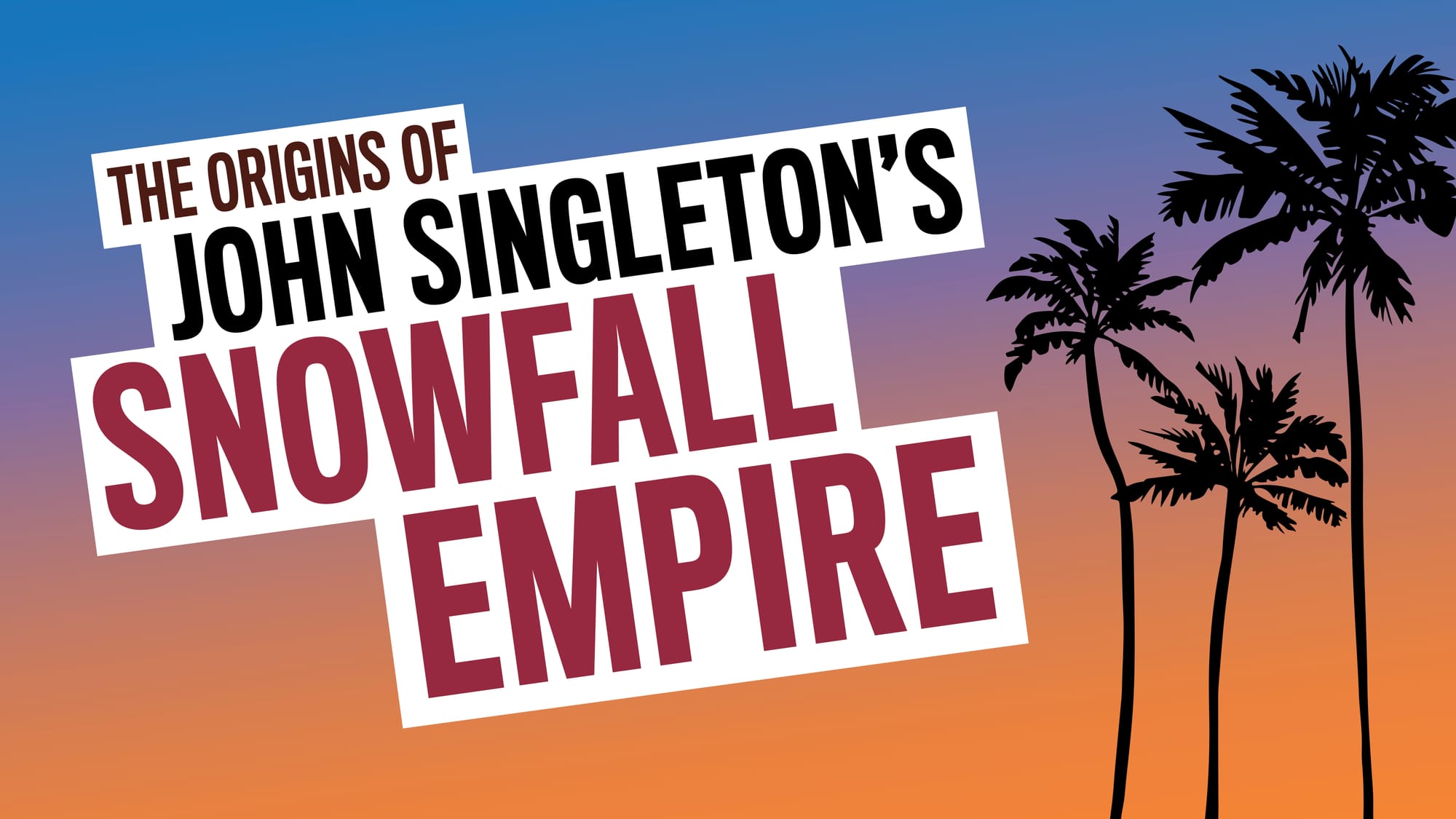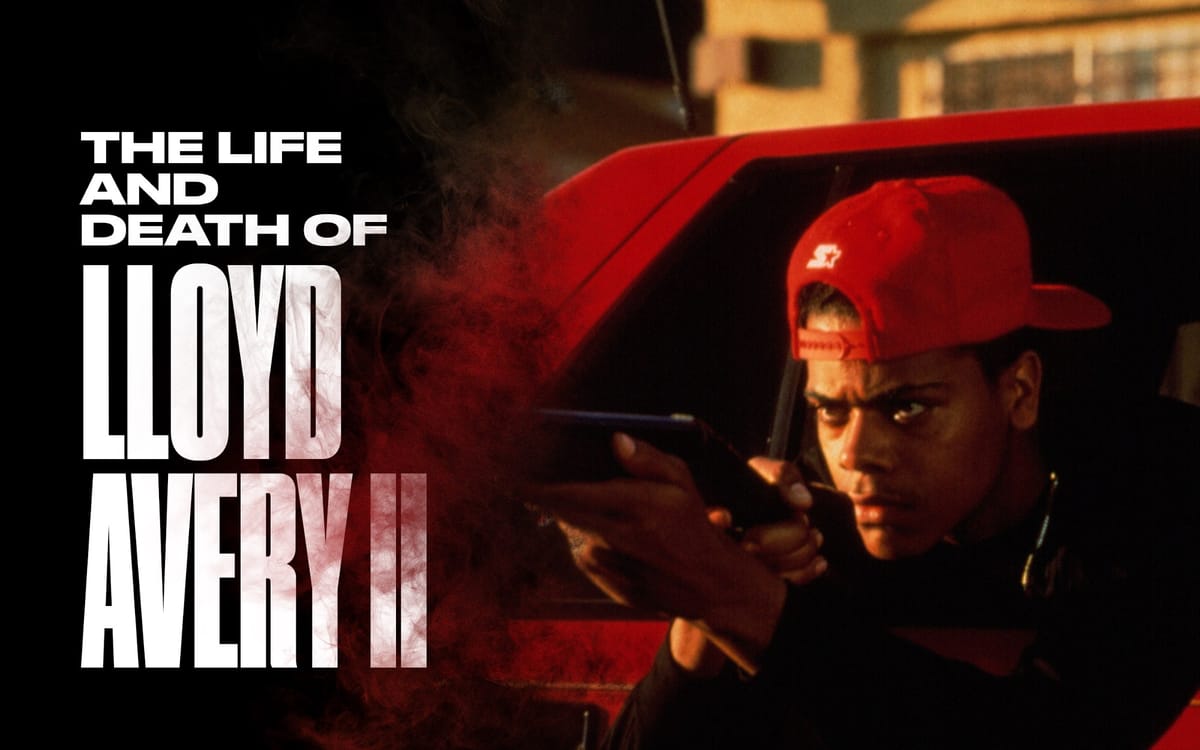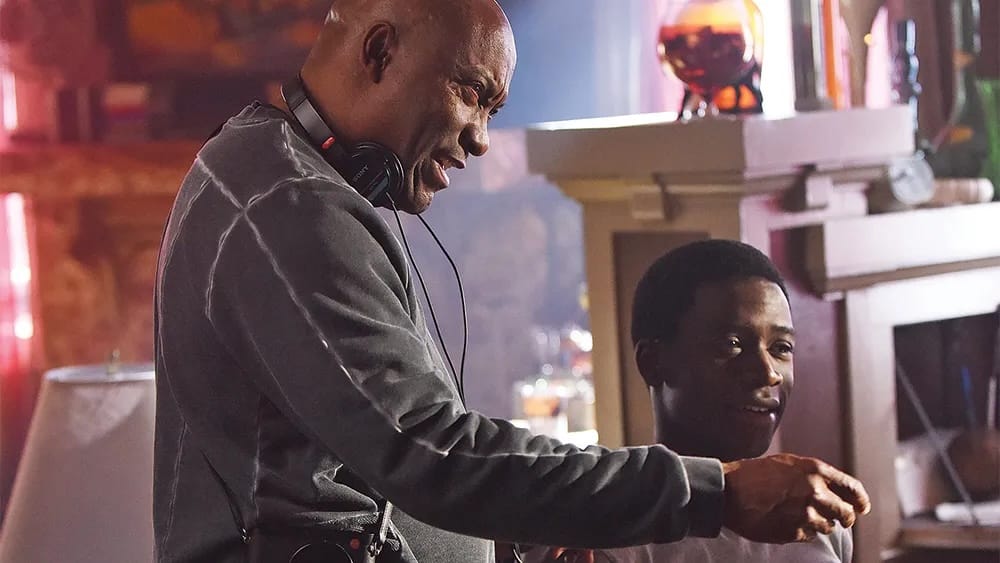
The Origins of John Singleton's Snowfall Empire
In an excerpt from the critically-lauded book, The Life of Singleton: From Boyz in the Hood to Snowfall, author Thomas Golianopoulos uncovers how the director went from dismissing television to creating one of the most important shows about Black Los Angeles for the small screen.
When John Singleton started out in the early 1990s, being referred to as a “TV director” was a slur. He once compared the work to selling drugs: Once you get in, there’s no getting out. But Singleton dabbled a bit, even though it felt like slumming.
In November 1997, he signed a seven-figure development and production deal with Warner Bros. TV to create programs for the studio. He immediately procured a six-episode commitment for CRASH, a one-hour drama about the LAPD SWAT team. ABC planned for it to debut in their fall 1998 lineup. But Singleton couldn’t be pried away from Shaft to work on a network show.
Every so often, he’d flirt with television. In the early 2000s, he developed a show with Menace II Society writer Tyger Williams at FX. He sold an hourlong drama about high-class sex workers to Showtime in 2007 called Trade. Epix showed some interest in a miniseries he pitched about the first government agents. But none of the shows made it out of development. His heart was never really in it. He had a blind spot toward television, missing out on opportunities to direct episodes of The Wire and The Shield. In 2008, Warner Bros. terminated his deal.

Singleton altered his stance once Abduction flopped and he landed in movie jail. The perception around television had also changed.
The prestige TV era was in full effect. Suddenly, the writing improved, the storytelling became more ambitious, the production values increased. HBO changed the game with The Sopranos, The Wire, and Sex and the City, then everyone got in on it. Showtime had Dexter, Weeds, and Homeland. American Movie Classics shifted from airing reruns of The Basketball Diaries and Volcano to original programing such as Mad Men and Breaking Bad. FX’s The Shield and Rescue Me scored millions of viewers and dozens of Emmy nominations.
With the movie industry focused more than ever on sequels and superheroes, feature film writers and directors flocked to television for the storytelling opportunities—and for the paychecks.
“When I realized they were going to give me twelve million bucks to make a one-hour pilot, I figured I’d take a shot at it,” Brett Ratner says about his decision to direct the pilot episode of Prison Break and executive-produce the series.
More than anything, television had overtaken film as a driver of pop culture. The internet acted as an accelerant—social media turned both big hits and niche shows into can’t-miss communal experiences that played out in Facebook and Tumblr posts, Twitter watch-alongs, Reddit threads, and the comments section on blogs.
Singleton slowly came around to recognize the moment. Now in exile, he had no choice.
The movie offers weren’t coming in. Meanwhile, Engelson haggled him to adapt his films into television. “Low-hanging fruit,” he called it.
About three months into working for him, Engelson approached Singleton with a compelling idea.
“I know it’s sacred, but what about doing Boyz N the Hood as a TV show?” he suggested.
“Nah, I’m not doing that.”
“Just call it: Boyz N the Hood: The Series.”
Singleton pursed his lips. He moved on.
“He never used the word sacrilege, but that’s the vibe I got,” Engelson says. Singleton wasn’t against mining his filmography for potential television. In August 2009, he tweeted, “Writing like a beast. Baby Boy the TV show coming in 2010.” But he didn’t have a clear vision of it yet.

Around this time, he could be found slouching in the beanbag in his office binge-watching The Sopranos on repeat. The more he learned about television, the more he realized he had to learn. Singleton studied how to write for episode cliffhangers and commercial breaks. He noticed the pacing in television moved faster. Close-ups were utilized more often than he preferred.
He had the benefit of several cicerones, friends and colleagues who worked in television, willing to walk him through the ins and outs of the business. The radically
different shooting schedule. The limited prep time. They gave him feedback on his scripts. Put him on to the politics of the industry. Schooled him on how the showrunner is king in television, while directors are interchangeable. How the network hovers over every part of the process. They’re looking at dailies, giving notes on actors, commenting on the script.
“It’s ten times worse than film,” Ratner says. “You have these television executives who’ve never made a film second-guessing every casting decision, every page. Who wants to be a part of that? The whole reason to be a feature film director was to have freedom.”
Singleton started taking some swings. In 2013, he sold Club Life: Miami, a drama about a reformed criminal falling into South Beach’s nightlife, to HBO, and was set to co-executive-produce the series with Russell Simmons. But he struggled with the script, cramming three episodes worth of plot into the pilot. The series didn’t move forward at the network.
But he soon met the right collaborator, a writer almost as obsessed with 1980s Los Angeles as he was, and who also wanted to make a television show about it.
Born into a military family in 1976, Eric Amadio grew up loving his country. His dad flew in the air force. Mom worked for J. Edgar Hoover’s FBI. His uncle fought in Vietnam. As a kid living on the border of Downey and Pico Rivera, Amadio had a front-row seat to the explosion of crack and the war between the Bloods and Crips. He lost his first friend to gang violence at the age of eleven. It wouldn’t be the last.
After graduating high school, Amadio, the grandson of an undocumented Italian immigrant, attended San Francisco State, a public university with a very activist and anti-government bent. And that’s where he learned that everything he had believed in was, in fact, a lie.
At the age of nineteen, Amadio read Dark Alliance, an investigative series published in the San Jose Mercury News. Over the course of three articles, reporter Gary Webb spun a tangled, shocking tale. Webb alleged that CIA agents smuggled cocaine into the United States, then used the profits to arm the Contras, a Nicaraguan anticommunist rebel group.
And what happened to the tons of nearly pure cocaine? It hit the streets, igniting the crack epidemic of the 1980s with South Central LA serving as its epicenter.

“I was furious,” Amadio says. “This was personal for me. I was raised to be a full-blown patriot and this notion that our government was involved in this really threw me for a loop.”
For the next fifteen years, he went down the rabbit hole researching the story. He hadn’t decided yet whether it would be a novel or a movie. But one thing remained certain: At some point, he’d write it. He came up with a plot. A good kid with family obligations meets a CIA agent with his back up against the wall. Together, they unleash a plague on the community. Amadio tabled the idea, though, as he worked his way into the film industry, writing and directing two small indie films in the late 2000s.
Like many young filmmakers of this era, Amadio transitioned to television. “It felt like getting sent to the minors,” he said. But he held an advantage over his peers. His experience in film allowed him to skip past the writers’ room grind and straight to pitching shows. He quickly sold a series to Starz about the business of professional football called Offseason.
“What’s next?” asked his agent, Evan Silverberg of Underground Films.
And that’s when Amadio mentioned his dream project: Red, White, and Blue. The red stood for the Bloods, the blue for the Crips, and the white was for the cocaine.
“That’s cool as shit,” Silverberg said. “Let’s bring it to Trevor.”
A few weeks later, Trevor Engelson invited Silverberg and Amadio to City Spa, a shvitz on Pico, to celebrate. They ordered some beers. Got a good sweat going.
Silverberg turned to Amadio. “Tell Trevor about your idea,” he said. Amadio laid out his plans for Red, White, and Blue.
“I want to do something about where I grew up,” Amadio said. “The neighborhood changed in the 1980s and it had everything to do with the CIA bringing in coke.”
Engelson scoffed and shook his head. “That’s an urban legend,” he said. “Folklore.”
Amadio recited a CliffsNotes version of Dark Alliance. “Look it up if you don’t believe me,” he said.
John is one of the reasons why I became a filmmaker. He showed an entire generation of kids, where there wasn’t hope. All my friends are tradesmen. We weren’t encouraged to dream. John was one of those dudes that made you go, ‘Fuck, it’s possible.’
Engelson’s eyes shone with excitement. “I just signed John Singleton,” he said. “He has something similar he’s really passionate about. Let’s put you guys together. See what happens.”
Amadio committed the instant he heard the name John Singleton.
“I’m a kid from the neighborhood,” he says. “John is one of the reasons why I became a filmmaker. He showed an entire generation of kids, where there wasn’t hope. All my friends are tradesmen. We weren’t encouraged to dream. John was one of those dudes that made you go, ‘Fuck, it’s possible.’ ”
He showed up late for a meeting on Singleton’s boat after Engelson handed him a slip number and wished him good luck. When Amadio arrived in Marina del Rey, he parked his car and meandered through the port, searching for the right dock. Finally, he found it. Singleton stood on his boat wearing board shorts and flip-flops. Big, warm smile on his face. He welcomed him aboard. They settled on the deck.
“Tell me about this idea,” Singleton said.
For the next hour or so, they talked about growing up in Los Angeles. Singleton remembered an era before crack—when the Spanish art deco homes didn’t have bars on their windows. Neighbors raised each other’s kids. People took pride in their lawns. Children played in the streets past dusk with streetlamps illuminating touch football games.
Then everything changed.
Red, White, and Blue offered Singleton an opportunity to tell these very Black, very California, very human stories he held dear. He jumped at the idea of partnering with Amadio.
They met frequently throughout early 2014, brainstorming storylines, hatching ideas, coming up with characters like a luchador turned cartel courier. Amadio would trigger Singleton’s memory and off he’d go for five, ten, fifteen minutes. He loved to tell stories about things that happened to him and events he had witnessed. He’d act out scenes. Maintain eye contact. Raise his voice. Sprinkle in little details he remembered (and some he embellished). Then he’d let out that cackle. The Laugh.
Singleton laughed with his entire body. His shoulders hunched up. His face would crinkle. It was a hissing, gurgling laugh that made him sound like Muttley, the Hanna-Barbera cartoon dog from Wacky Races. If he was really feeling it, he’d just go crazy, clapping his hands and smacking his knee.
Singleton, unassumingly, straddled the line between socially awkward and charismatic.
Both he and Amadio realized early on there were parallels between the dramatic series they were creating and the life of Freeway Rick Ross, the Los Angeles crack kingpin who, according to prosecutors, amassed nearly $300 million in profits between 1982 and 1989. Ross was sentenced to life in prison in 1996—the same year the Dark Alliance series reported on the link between his operation and the Iran-Contra affair.
Singleton had breakfast with him in the early 1990s and encountered Ross again after he got out on appeal in 2009. There was talk of a collaboration, maybe a movie. “He was helping me put my script together,” Ross said. From there, Ross claims, Singleton ghosted him.
“John and I always made a point not to do the Freeway Ricky story,” Amadio says. “It was more a correlation of these different neighborhood legends. Certainly, Freeway Ricky was the guy and the biggest. But there was a bigger story about America that we were more interested in telling.”
One afternoon, Amadio showed up at the marina to review the final pitch document with Singleton—one last appraisal before meeting with the networks. When he got there, he noticed him smiling from ear to ear.
“Come on, come on,” Singleton said, sliding across the deck. “So, I was thinking about the title. I don’t know, man.”
“I’m not in love with it either,” Amadio admitted.
“So, I think I have something. It’s good.”
“What is it?”
“Guess.”
“I can’t. Just tell me.”
“Are you sure? You don’t want to guess? It’s good.”
“John, what’s the new title?”
“Snowfall.”
The Life of Singleton: From Boyz in the Hood to Snowfall is out now. Purchase your copy here.

